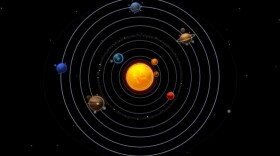This summer, Mars will highlight the night sky as it will be closer and brighter than it has been in years. In honor of this, this week we’ll continue talking about Mars. Mars is named after the Roman god of war, presumably due to its red color and reds association with blood and violence. Mars gets its red color from the large amount of iron oxide in the soil of Mars; we know iron oxide better as rust. How exactly Mars’ soil was oxidized is still a bit of mystery that is connected to the speculation of ancient life on Mars, but that discussion will be saved for another week in the near future. Mars has been observed since prehistoric times and has extensively studied since then. Mars is a favorite observing destination of many ground-based telescope, even though it is considered very difficult to observe due to its size. Mars is about half the size of the Earth, but without any oceans has about the same land area as the Earth.
Mars can range in distance from the Earth from 55 million km to 400 million km based upon the positions of Earth and Mars in their orbits. The first spacecraft to visit Mars was Mariner 4 in 1965. Several followed, including the Viking landers in 1976, Pathfinder in 1997, Spirit and Opportunity in 2004, and the Curiosity rover in 2012. Many of these of course are no longer in operation, but the nuclear-powered Curiosity rover recently celebrated its 2000th day on Mars and is still going strong. Mars has a wide variety of interesting terrains, including: Olympus Mons, the largest volcano in the solar system with a size three times that of Mt. Everest; and Valles Marineris, the largest canyon in the solar system at 4000 km long (about the distance from San Francisco to Washington DC) and ranging in depth from 2 to 7 km.
Next week we’ll continue talking about Mars and the possibility of past and current life on Mars.
--
Follow your curiosity to the Fred G. Dale Planetarium at Wayne State College





